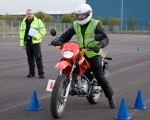 Go to main content
Go to main content
Archive Website of the UK government
Please note that this website has a UK government accesskeys system.
Main menu
Page menu
Motoring

Compulsory basic training (CBT): what the course involves

All learner motorcycle and moped riders must complete a compulsory basic training (CBT) course before riding on the road. Find out what happens during the five elements that make up a CBT course for moped and motorcycle riders.
How the training is organised
Top tip
Don't treat CBT as a formality - trainers are experienced motorcyclists who have valuable advice to give you
CBT is arranged so that you progress through a series of elements. You'll only move on to the next element when your trainer is happy you have:
- learnt the necessary theory
- shown the practical skills to a safe basic level
Within each element the trainer is free to deliver the training in the order they feel is right for you.
How many people you'll train with
During your CBT you might train with other learners up to a maximum of:
- four learners to every trainer during on-site elements
- two learners to every trainer during on-road elements
Don't treat CBT as a formality - trainers are experienced motorcyclists who have valuable advice to give you.
How to find out more about CBT
You can find more detailed information about what to expect during your CBT in the book 'The official DSA guide to learning to ride'.
Element A - introduction to CBT
Introduction to CBT
At the end of this element you should understand the purpose and content of CBT
Your trainer will explain the basics and not go into complicated issues.
Wherever possible your trainer will use examples to help explain the points they make.
You'll have your right to ride mopeds or motorcycles checked. If necessary your trainer will explain what you need to do in order to get this right - for example, apply for a provisional motorcycle licence.
At the end of this element you should understand the purpose and content of CBT.
What element A covers
Overall, the element will cover:
- an overview of CBT
- equipment and clothing
- an eyesight check
Element B - practical on-site training
On-site training
You won't start riding the motorcycle in this element, but you'll get hands-on training
This element introduces you to the motorcycle. You won't start riding the motorcycle in this element, but you'll get hands-on training.
At the end of this element you:
- will be able to show knowledge of how the motorcycle works
- should have a feel for the weight and balance of the motorcycle
What element B covers
Overall, the element will cover:
- motorcycle controls
- basic safety checks and use of the stands
- wheeling the motorcycle and braking to stop
- starting and stopping the engine
Element C - practical on-site riding
On-site riding
In this element you'll begin riding a motorcycle - by the end you'll be able to ride a motorcycle under control
In this element you'll begin riding a motorcycle. By the time you have finished this element you'll have developed enough basic skills to allow you to ride a motorcycle under control.
You’ll learn the essential techniques including:
- rear observation
- the 'observation - signal - manoeuvre' (OSM) routine
- the 'position - speed - look' (PSL) routine
You will then practise these practical skills until your trainer is happy that you'll be safe when you are taken out onto the road.
What element C covers
Overall, the element will cover:
- riding in a straight line and stopping
- riding slowly
- using the brakes
- changing gear
- riding a figure of eight
- emergency stop
- rear observation
- turning left and right
- u-turns
Element D - practical on-road training
On-road training
This element will cover the information you need to ride legally and safely on the road
Having carried out theory and practical training off-road, your trainer will now prepare you for the on-road element of CBT.
This element will cover the information you need to ride legally and safely on the road. It will be the foundations on which you build your motorcycling career.
During element E parts of this theory may be reinforced in practical situations.
What element D covers
Overall, the element will cover:
- being visible to other road users
- legal requirements
- vulnerability of motorcyclists
- speed
- Highway Code
- anticipation
- rear observation
- road positioning
- separation distance
- weather conditions
- road surfaces
- alcohol and drugs
- attitude
- hazard perception
Element E - practical on-road riding
On-road riding
You'll ride out on the road with a certified trainer for at least two hours
This is the final element of the CBT course. You'll ride out on the road with a certified trainer, and possibly with one other trainee, for at least two hours. You'll be in radio contact with the trainer.
You'll have to prove that you can cope safely with a variety of road and traffic conditions.
Expect your trainer to stop sometimes to discuss some aspects of your riding. They will also explain how the theory you have learnt should be put into practice.
Your riding will be assessed constantly by your trainer. They will sign a certificate of completion (DL196) when they are happy you are safe to continue learning alone.
What element E covers
Overall, the element will cover:
- traffic lights
- roundabouts
- junctions
- pedestrian crossings
- riding on slopes and hills
- bends
- obstructions
- u-turns
- an emergency stop
More useful links
Additional links
Simpler, Clearer, Faster

From 17 October, GOV.UK will be the best place to find government services and information
 Facebook
Facebook Twitter
Twitter StumbleUpon
StumbleUpon Delicious
Delicious Reddit
Reddit
